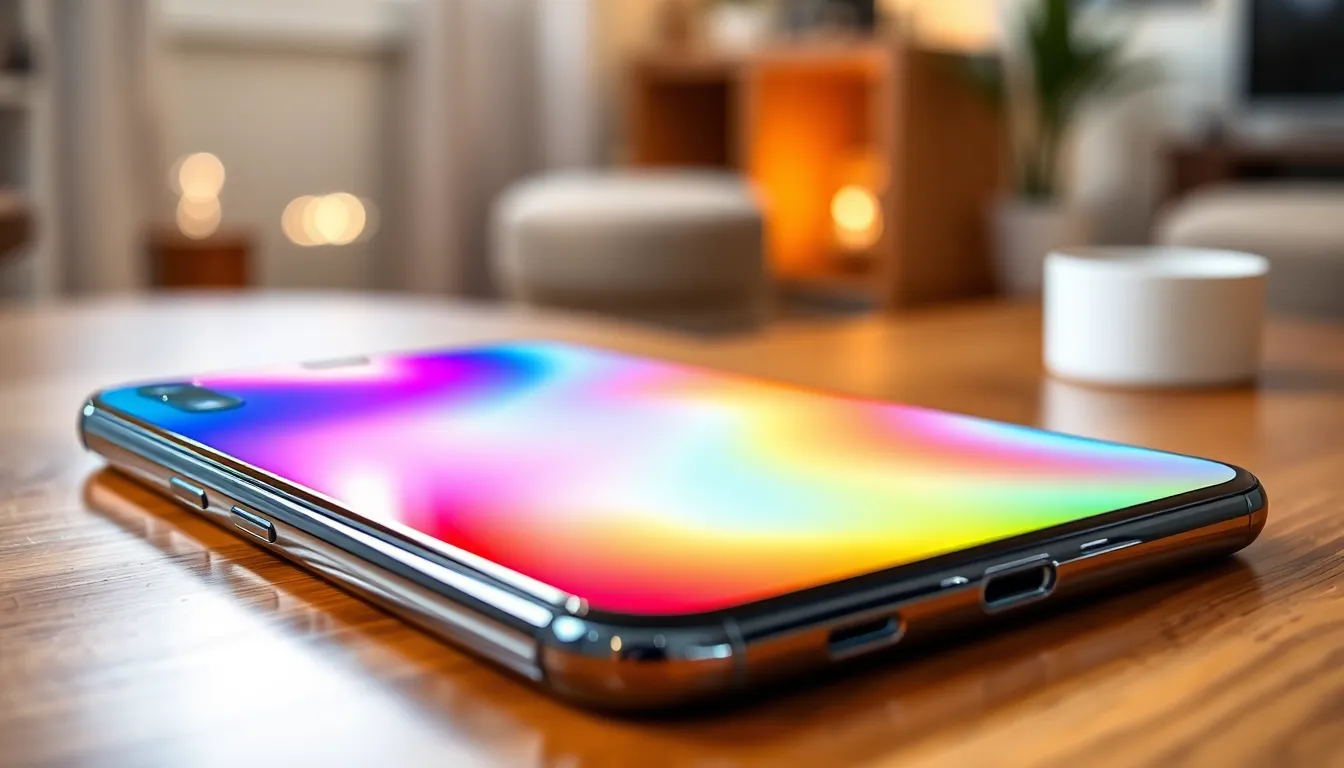In a world where smartphones are practically an extension of our hands, knowing the ins and outs of phone specifications can make or break your next purchase. It’s not just about the shiny new colors or the latest trendy features; it’s about understanding what really makes a phone tick. After all, nobody wants to invest in a device that can’t keep up with their meme-sharing habits or binge-watching marathons.
Imagine trying to explain to your friends why your phone’s camera can’t capture that perfect sunset shot. Awkward, right? By diving into the nitty-gritty of phone specs, readers will not only sound like tech gurus but also make informed choices that suit their lifestyle. So buckle up and get ready to decode the jargon that’ll help anyone become the proud owner of a smartphone that truly delivers.
Table of Contents
ToggleOverview of Phone Specifications
Understanding phone specifications is crucial for making informed purchasing decisions. Key specifications include the processor, memory, battery capacity, camera quality, and display features. Each of these components plays a significant role in the overall performance and user experience of a smartphone.
The processor, often referred to as the brain of the phone, determines how smoothly applications run and multitasking capabilities. For instance, devices with higher gigahertz ratings typically perform better in demanding tasks.
Memory, measured in gigabytes, affects the device’s ability to store applications and manage active tasks. A phone with at least 4GB of RAM is advisable for smooth performance, especially for users engaged in gaming or heavy multitasking.
Battery capacity, expressed in milliampere-hours (mAh), indicates how long a device can operate before needing a recharge. Generally, a smartphone with a battery capacity of 4000mAh or more provides better longevity for daily tasks.
Camera specifications, such as megapixels and aperture size, determine the quality of photos and videos. A higher megapixel count often indicates better detail, while a lower aperture number allows more light in, enhancing photo quality under low-light conditions.
Display specifications include size, resolution, and technology type (e.g., OLED, LCD). These factors affect clarity and color representation. For an optimal viewing experience, a resolution of at least 1080p is recommended.
Familiarizing oneself with these specifications promotes a deeper understanding of a smartphone’s capabilities. This knowledge enables users to select devices that align with their preferences, ensuring satisfaction with their purchase.
Key Components of Phone Specifications

Understanding key components of phone specifications enables better decision-making during purchases. Each element significantly influences user experience and functionality.
Processor and Performance
The processor functions as the brain of the smartphone, directly affecting performance. Current models often use processors like Qualcomm Snapdragon or Apple A-series. High-performance processors enhance app loading times, multitasking, and overall speed. Typical users benefit from a minimum of four cores for efficient operation. Moreover, advanced graphics capabilities assist gamers and creative applications by delivering smoother visuals.
RAM and Storage Options
RAM plays a crucial role in a smartphone’s performance concerning multitasking and speed. Many devices come equipped with 4GB to 12GB of RAM, providing varying levels of efficiency. Larger RAM sizes allow for smoother operation while running multiple applications simultaneously. Storage options span from 64GB to 512GB or more, impacting how much data a user can keep. Additional features like expandable storage via microSD cards further enhance flexibility.
Display Features
Display features significantly affect user experience and visual satisfaction. Common specifications include size, resolution, and panel type. Display sizes typically range from 5 to 7 inches, making them convenient for various tasks. High-definition resolutions such as Full HD or 4K improve clarity, thereby enhancing multimedia consumption. OLED and AMOLED technologies ensure better color accuracy and deeper blacks, providing superior viewing experiences.
Camera Specifications
Camera specifications significantly influence photo and video quality. Understanding these features can help users select the right device for their needs.
Rear Camera Capabilities
Rear camera capabilities typically focus on megapixels, aperture size, and additional features. Most modern smartphones offer megapixels ranging from 12 to 108, enhancing detail in images. An aperture size of f/1.6 or lower improves low-light performance, capturing brighter pictures. Users often appreciate features like optical image stabilization (OIS), which reduces blur from shaky hands, and multiple lens setups for versatility. Common configurations include ultra-wide, telephoto, and macro lenses, allowing for various photography styles. Taking into account these specifications aids in capturing striking photos suitable for social media and sharing.
Front Camera Features
Front camera features are essential for selfies and video calls. Megapixel counts usually range from 8 to 32, with higher numbers providing clearer images. Aperture sizes often vary from f/2.0 to f/2.4, affecting low-light performance. Many front cameras include portrait mode and beauty filters, enhancing users’ selfies. Wide-angle capabilities also enable group shots without crowding. Knowing these aspects equips individuals with the necessary insight to choose a smartphone that excels in front-facing photography.
Connectivity Options
Connectivity options play a crucial role in enhancing a smartphone’s usability. Understanding these options ensures users select devices that meet their connectivity needs.
Network Support
Network support varies widely among smartphones. Most modern devices support multiple generations of mobile networks, including 4G LTE and 5G. 5G networks provide faster download speeds, reduced latency, and improved overall performance, making them ideal for streaming videos and online gaming. A device with 5G capability offers future-proofing against evolving network technology. Users should consider their local network availability to fully utilize these advanced features. Additionally, dual-SIM support is common in many smartphones, allowing users to manage personal and work numbers seamlessly.
Wireless Technologies
Wireless technologies significantly enhance smartphone functionality. Bluetooth 5.0 and above deliver faster data transfer rates and improved range, allowing seamless connections to accessories like headphones and smartwatches. Wi-Fi 6 provides higher speeds and better performance in crowded areas, making it ideal for homes and offices with multiple connected devices. Near Field Communication (NFC) enables quick mobile payments and easy pairing with other devices. Understanding these wireless capabilities helps users maximize their smartphone’s potential and stay connected efficiently.
Battery Life and Charging
Battery life plays a crucial role in user satisfaction and functionality. Typical capacities range from 4000mAh to 5000mAh. Devices with 4000mAh often provide a full day of usage under average conditions. Many higher-end models offer even greater capacities, extending usability significantly.
Fast charging technologies enhance convenience. Most smartphones support fast charging, allowing users to gain substantial battery life in a short time. It’s common to find charging speeds from 15W to 65W. With 15W charging, phones can charge moderately quick, while 65W can fully charge a device in under 40 minutes.
Wireless charging has gained popularity, adding flexibility for users. Standard wireless charging rates typically range from 5W to 15W. Devices supporting 15W wireless charging offer faster replenishment than those with standard 5W options. Furthermore, reverse wireless charging enables users to share power with other devices like earbuds or smartwatches.
Battery longevity matters as well. Lithium-ion batteries can degrade over time, impacting performance. Regular cumulative charging cycles affect longevity; most manufacturers suggest replacing a battery after 300 to 500 cycles. Users should monitor battery health features provided in their device settings to maximize lifespan.
Overall, understanding battery specifications aids decision-making when selecting a smartphone. Prioritize devices with higher capacities and swift charging capabilities for the best experience.
Being informed about smartphone specifications is essential for anyone looking to make a smart purchase. By understanding key features like processor performance memory capacity and battery life users can select devices that truly fit their needs. This knowledge not only enhances everyday experiences but also ensures that users avoid potential frustrations with underperforming devices.
As technology continues to evolve staying updated on specifications will empower users to choose smartphones that excel in connectivity photography and overall performance. Embracing this knowledge transforms consumers into savvy smartphone owners ready to enjoy the full potential of their devices.



